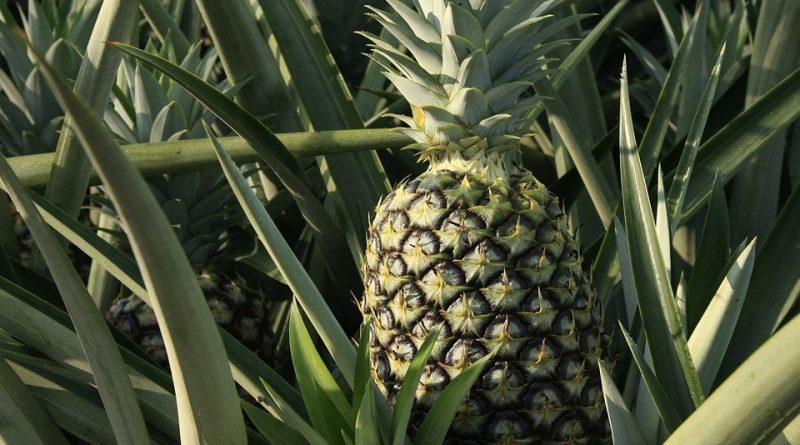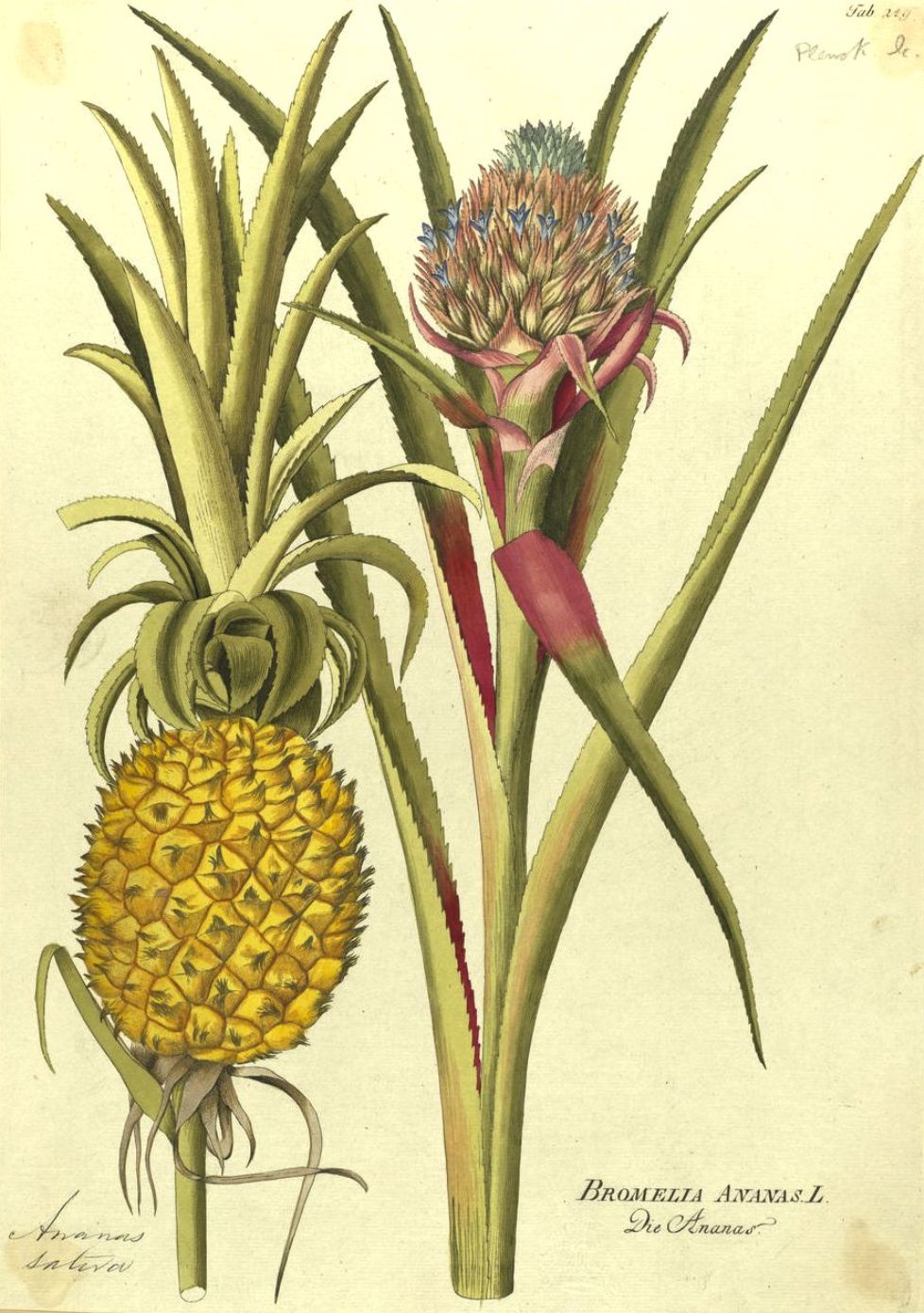Ananas comosus
Ananas comosus
Pineapple (Ananas comosus (L.) Merr.) is an herbaceous plant belonging to the Bromeliaceae family.
Systematics –
From the systematic point of view it belongs to the Domain Eukaryota, Kingdom Plantae, Division Magnoliophyta, Class Liliopsida, Order Bromeliales, Family Bromeliaceae and then to the Genus Ananas and to the Specie A. comosus.
Etymology –
The term Pineapple comes from nanas, a vernacular voice that used, for the plant, the Guarani Indians of South America which means flower, perfume. The specific epithet comosus comes from cóma canopy: crowned, chiomed.
Geographic Distribution and Habitat –
The Ananas comosus is a species most likely native to an area located between Brazil and Paraguay. The plants present today in the cultivations are the result of a long selection started already in pre-Columbian times.
Description –
The pineapple is an herbaceous perennial terrestrial plant, evergreen, monocarpica (ie, fruiting only once and then dies), with a short stem, consisting of a rosette of ribbon-like leaves, coriaceous, of gray-green color, tending to reddish if exposed in full sun, long up to 1.5 m. (length that can be considerably lower in cultivated plants) and 4-5 cm broad, from edges with curved sharp spines and with a thorn at the end; among the cultivated varieties they exist with more sparse or unarmed spines, selected to facilitate cultivation and harvesting of the fruit. It is endowed with a floral scape, robust, 30 to 50 cm long that develops in the center of the rosette and ends with a globose inflorescence, dense, about 30 cm long, with a variable number of flowers from 50 to 200 of each 12-24 mm, subtended by a bract that can have a green, yellow or red color, with a dense tuft of leaves on top.
Flowering proceeds from bottom to top; in a period ranging from 15 to 30 days: The flowers are bisexual, but self-incompatible and the fructification takes place by parthenocarpy (development of the fruit without there being fertilization); from fertilization a compound fruit is formed (syncrop) of an initially green color, then yellow or orange when ripe, formed by the fusion of ripe ovaries with the base of the sepals and bracts and with the bark of the floral axis whose tissues, swelling , they become fleshy and juicy.
Cultivation –
The Ananas comosus is a species that for its cultivation requires a minimum winter temperature of 16-18 ° C, with a lot of light, without direct sun, especially in the summer months. The cultivation environment requires high humidity and recourse to frequent summer and reduced irrigation in winter. Each plant takes one year and six months to produce a single fruit. For the specific cultivation technique, this sheet can be consulted.
Uses and Traditions –
The Ananas comosus was discovered by Columbus in 1493. From here derives the etymology of the name, the Indians called this fruit with the common name “anana” or “scent”, while the conquistadores believed it was a sort of tropical “piña”, indeed Indian and even in Europe it was called “real pigna”, given its cost in fact only the royals could feed on it.
Imported into Europe, it spread to England in the VXII where it was not immediately a great success, so it headed east, where it was much appreciated by Asians. Finally, the pineapple arrived in Hawaii where the cultures progressed, thanks also to the fact that at that time they already knew its properties: the conquistadores in fact they ate it to prevent scurvy because this fruit is rich in vitamin C.
Two notes on curiosities: in ancient times it was believed that pineapple was a symbol of hospitality, while in some tribal rituals it symbolizes strength and success; the Aztecs wrote the name that also had the meaning of “she-who-is-beautiful-even-when-out-it rains”.
The main benefits of pineapple are due to the presence of bromelain, the well-known active ingredient that confers the characteristic properties of this fruit. The beneficial properties of pineapple are:
– digestive properties: bromelain helps to digest proteins (this property had already been discovered in the eighteenth century) but also proves useful to those suffering from dyspepsia;
– anti-inflammatory properties: unlike drugs, bromelain has no toxic effects and can also alleviate trauma and edema, as well as relieve the pain caused by arthritis;
– diuretic properties: pineapple is excellent for fighting cellulitis and water retention;
– antioxidant properties: this fruit helps to keep young and healthy, as well as bright skin, preventing wrinkles and premature aging;
– anti-flu properties: the great resource of vitamin C helps to prevent seasonal ills such as coughs, colds, flu and sore throats.
To fully exploit the properties of bromelain, the pineapple should not be cooked but eaten raw, cooking but also the syrup can lose this fruit almost all its beneficial properties.
Preparation Mode –
In gastronomy, pineapple can be eaten raw or cooked in various preparations such as sweet and sour sauce; it is also industrially processed for the preparation of syrups, jams, etc.
Guido Bissanti
Sources
– Acta Plantarum – Flora of the Italian Regions.
– Wikipedia, the free encyclopedia.
– Treben M., 2000. Health from the Pharmacy of the Lord, Advice and experience with medicinal herbs, Ennsthaler Publisher
– Pignatti S., 1982. Flora of Italy, Edagricole, Bologna.
– Conti F., Abbate G., Alessandrini A., Blasi C. (edited by), 2005. An annotated checklist of the Italian vascular flora, Palombi Editore.
Warning: Pharmaceutical applications and alimurgical uses are indicated for informational purposes only and do not in any way represent a medical prescription; there is therefore no liability for their use for curative, aesthetic or food purposes.


